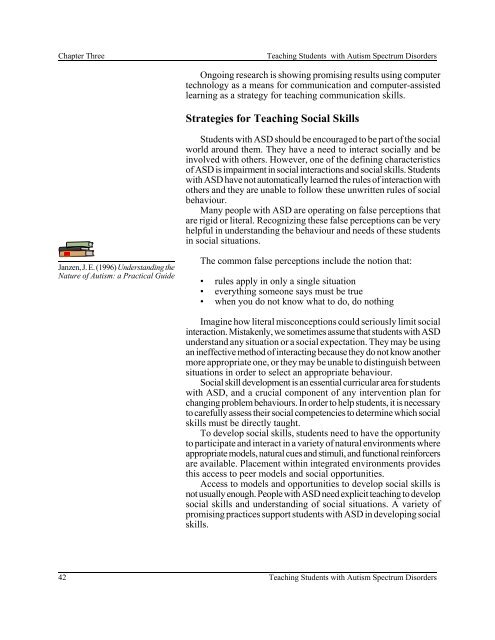Teaching Students with Autism Spectrum Disorders
Teaching Students with Autism Spectrum Disorders
Teaching Students with Autism Spectrum Disorders
Create successful ePaper yourself
Turn your PDF publications into a flip-book with our unique Google optimized e-Paper software.
Chapter Three <strong>Teaching</strong> <strong>Students</strong> <strong>with</strong> <strong>Autism</strong> <strong>Spectrum</strong> <strong>Disorders</strong><br />
Janzen, J. E. (1996) Understanding the<br />
Nature of <strong>Autism</strong>: a Practical Guide<br />
Ongoing research is showing promising results using computer<br />
technology as a means for communication and computer-assisted<br />
learning as a strategy for teaching communication skills.<br />
Strategies for <strong>Teaching</strong> Social Skills<br />
<strong>Students</strong> <strong>with</strong> ASD should be encouraged to be part of the social<br />
world around them. They have a need to interact socially and be<br />
involved <strong>with</strong> others. However, one of the defining characteristics<br />
of ASD is impairment in social interactions and social skills. <strong>Students</strong><br />
<strong>with</strong> ASD have not automatically learned the rules of interaction <strong>with</strong><br />
others and they are unable to follow these unwritten rules of social<br />
behaviour.<br />
Many people <strong>with</strong> ASD are operating on false perceptions that<br />
are rigid or literal. Recognizing these false perceptions can be very<br />
helpful in understanding the behaviour and needs of these students<br />
in social situations.<br />
The common false perceptions include the notion that:<br />
• rules apply in only a single situation<br />
• everything someone says must be true<br />
• when you do not know what to do, do nothing<br />
Imagine how literal misconceptions could seriously limit social<br />
interaction. Mistakenly, we sometimes assume that students <strong>with</strong> ASD<br />
understand any situation or a social expectation. They may be using<br />
an ineffective method of interacting because they do not know another<br />
more appropriate one, or they may be unable to distinguish between<br />
situations in order to select an appropriate behaviour.<br />
Social skill development is an essential curricular area for students<br />
<strong>with</strong> ASD, and a crucial component of any intervention plan for<br />
changing problem behaviours. In order to help students, it is necessary<br />
to carefully assess their social competencies to determine which social<br />
skills must be directly taught.<br />
To develop social skills, students need to have the opportunity<br />
to participate and interact in a variety of natural environments where<br />
appropriate models, natural cues and stimuli, and functional reinforcers<br />
are available. Placement <strong>with</strong>in integrated environments provides<br />
this access to peer models and social opportunities.<br />
Access to models and opportunities to develop social skills is<br />
not usually enough. People <strong>with</strong> ASD need explicit teaching to develop<br />
social skills and understanding of social situations. A variety of<br />
promising practices support students <strong>with</strong> ASD in developing social<br />
skills.<br />
42 <strong>Teaching</strong> <strong>Students</strong> <strong>with</strong> <strong>Autism</strong> <strong>Spectrum</strong> <strong>Disorders</strong>

















